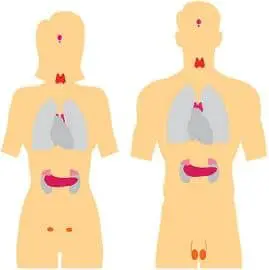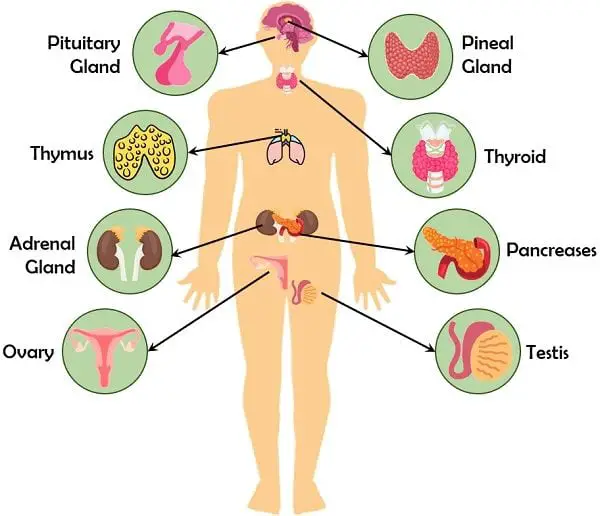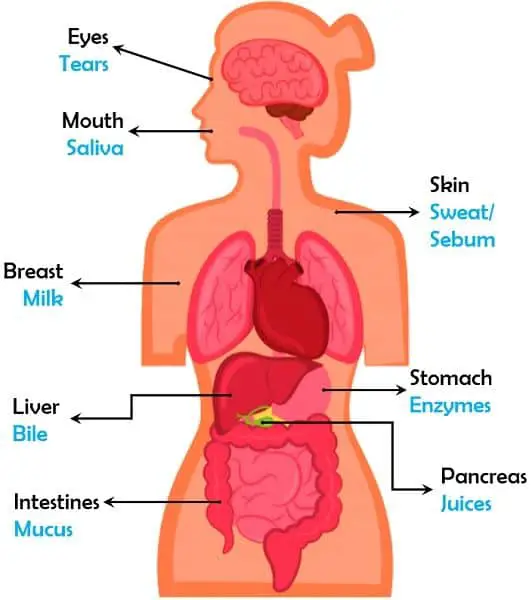Glands are the ingrowth of the top layer of the skin i.e. epithelium. This ingrowth can have a tubular, simple, branched or compound formation. They are the group of cells that release a chemical substance as per the demand of the body. We can divide them into two categories- Endocrine and Exocrine. These two play a critical role in controlling the body, its growth and development and other functions.
The nature of the secretion is one of the critical points to distinguishing both glands. Endocrine glands secrete hormones. Whereas exocrine glands secrete substances like enzymes, digestive juices, sweat, saliva, etc.
Another point where these glands vary is the presence or absence of the ducts to secrete the chemicals.
The endocrines are ductless glands while the exocrine use the ducts for carrying their material.
The exception is the Pancreas and Liver which are Mixocrine Glands as they serve as both the endocrine as well as exocrine glands. They secrete both hormones as well as enzymes. Glands are the group of cells or an organ that release chemical substances. These substances can be in the form of enzymes, hormones, sweat, digestive juices, saliva, etc.
In this context, we will be covering the points on which both glands differ, with a summary.
Content: Endocrine Vs Exocrine Gland
Comparison Chart
| Basis for Comparison | Endocrine Gland | Exocrine Gland |
|---|---|---|
| Meaning | Such glands which secrete hormones into the bloodstream and then it is transported to the target tissue, cells and organs or in an internal environment around the cells. | The glands which secrete its substances or enzymes with the help of the duct on the epithelial surface or into the external environment. |
| Ducts (channel or tube) | Ductless glands. | They have ducts to in order to send their substance. |
| Response Time | They show the delay in response as any substance released by them (glands) is carried by blood and it takes time. | They show the quick response, as they are secreted on the target site. It secretes Hormones. Sweat, Saliva, Enzymes and milk. |
| Period of Action | These are active for a long term, though slow in response. | They are active for the short term, though quick in response. |
| It is transported | Through blood, even the secretions are released into the bloodstream. | Through ducts or tube; secreted substances are directly released on the site or tissue. |
| Types | These are of two kinds which are the primary endocrine gland and secondary endocrine gland. | These are of various types like the serous gland, mucous gland, apocrine gland, merocrine glands, unicellular exocrine glands, multicellular exocrine glands, and mixed glands. |
| Examples | Pituitary, thyroid, adrenal, testes, hypothalamus, etc. | Sweat gland, salivary gland, gastric, etc. |
| Functions | 1. It helps in the growth and development of the body,metabolism. 2. It maintains water and electrolyte balance. | Regulate body temperature by producing sweat. |
Definition of Endocrine Gland
As the word says “Endo” means inside, and “Crine” means to secrete. These glands are mainly known for producing hormones. The first thing that comes into mind about this gland is that it is ductless and releases its secretions into the bloodstream. In simple words, we can say that they do not possess any tube or passage through which they can send their hormones to the essential place in the body.
Thus the endocrine gland sends their secretions via the bloodstream which discharges into the interstitial spaces. Examples of Endocrine glands are the pituitary gland, adrenal gland, thyroid gland, hypothalamus, etc.
The endocrine gland shows a slow response, but its effect remains for the long term. It also functions in maintaining the homeostasis of the body by regulating and coordinating various activities. This may include functions like:
- Daily metabolism
- Growth and development
- Reproduction
- Sleep
There can be the chances of occurrence of the disease when the hormonal level in the body gets disturbed. It can be due to stress, body unresponsiveness, infection, or certain imbalances. Some of the common diseases that occur due to hormonal imbalance are:
- Hypothyroidism or Hyperthyroidism,
- Hypo or hyperglycemia (Diabetes)
Definition of Exocrine Gland
“Exo” means outside and “Crine” means to secrete, so Exocrine means to ‘To secrete outside‘. These glands have ducts and secrete substances like saliva, mucus, enzymes, sweat, etc.
Exocrine glands release their substances on the epithelial surface of the body. They are present on the target site or the place wherever needed in the body.
Exocrine glands respond quickly but not for an extended period. There are numerous medical conditions, which may be due to the ill effects of the exocrine glands. This may include:
- Infections
- Ulcers
- Cysts
- Cancer
- Tumour
- Genetic disorders
- Obstructions
- Cystic Fibrosis
- Addison’s Disease
- Acromegaly
Key Differences Between Endocrine and Exocrine Glands
- Endocrine glands are ductless glands. Thus they tend to deliver their secreted hormones straight into the bloodstream. And through the bloodstream, the secretions reach the target tissue, cells, and organs. On the other hand, exocrine glands have ducts. They secrete the enzymes with the help of the duct on the epithelial surface or to the target site.
- The endocrine gland shows a delay in response as the bloodstream carries the secretions, which take time. In contrast, the exocrine gland shows a quick response, as they are directly secreted on the target site.
- Endocrine glands secrete hormones. On the other side, exocrine glands sweat, saliva, enzymes and milk (mammary glands).
- Endocrine glands show a slow response and are active for a long time. While exocrine glands are active for a short term but show a quick response.
- Endocrine glands transport the secretions through the bloodstream. Exocrine glands are ducts or tube-secreted substances that are directly released on the site or tissue.
- Endocrine glands are of two types which are the primary endocrine gland and the secondary endocrine gland. Exocrine glands are of various types like the serous gland, mucous gland, apocrine gland, merocrine glands, unicellular exocrine glands, multicellular exocrine glands, and mixed glands.
- The pituitary, thyroid, adrenal, testes, hypothalamus, etc. are examples of endocrine glands. On the other hand sweat gland, salivary glands, mammary glands, gastric, etc. are examples of exocrine glands.
- The functions of the endocrine glands are in the growth and development of the body, and metabolism. Also, it maintains water and electrolyte balance. Whereas exocrine glands regulate body temperature by producing sweat.
Conclusion
Our body functions in the coordination, regulation, and control of the different cells, tissues, and organs present. They provide signals and work according to the needs of the body. In this article we look up the distinct aspects on which the two types of glands differ, we also came to know their importance in the human body.




Leave a Reply